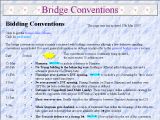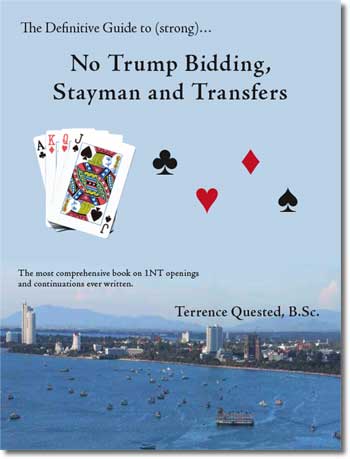| to news-sheet main page |
 |
||||
| to Pattaya Bridge home page |
|||||
 |
to bridge book reviews | to bridge conventions | to No Trump bidding | ||
| to bridge CD's and computer games and software | |||||
Mon 9th N-S 1st Lars B & Lars G 63% 2nd Janne & Richard 55%
E-W 1st Hans & Paul Sc 56% 2nd Sigurd & Tom 54%
Wed 11th N-S 1st Mike Wiss & Paul Q 60% 2nd Lars b & Jean 56%
E-W 1st Janne & Per-Ake 65% 2nd Hans V & Royd 58%
Fri 13th N-S 1st Janne & Lars B 56% 2nd Tomas & Dave 55%
E-W 1st Kristen & Richard M 57% 2nd = Gerry Cohen & Terje Loee 56%
= Ian Wheeldon & Knud 56%
Bidding Quiz Standard
American bidding is assumed unless otherwise stated.
Hand A Hand B With Hand A LHO opens a Multi 2♦, partner passes and
♠
K1062 ♠ Q doubles, what do you do? So: 2♦ pass 2♥ pass
♥ 3 ♥ AK87 pass 2♠ dbl ?
♦ QJ75 ♦ J1092
(b) If so, what do you open? And what is
your rebid when partner
bids 1♠?
C 2♥ 2♠ dbl 2♥ is weak. What is
the double – negative or penalties?
D 1NT pass 2♣ pass 2♣ is Stayman, what is
4♣ - ace ask, keycard ask or a splinter?
2♠ pass 4♣ and what would 4NT by responder be – ace ask or quantitative?
Current club championship standings
|
|
Gold Cup = Best 30 |
Silver Plate = Best 10 |
Bronze Medal = Best 5 |
|
1 2 3 4 5 6 7 8 9 10 |
1949.2 Janne Roos 1924.0 Hans Vikman 1891.4 Paul Quodomine 1804.7 Sally Watson 1734.7 Ivy Schlageter 1725.8 Bob Short 1721.4 Bob Pelletier 1721.3 Paul Scully |
690.6 682.1 659.1 636.6 Sally Watson 631.2 Per-Ake Roskvist 625.4 Jeremy Watson 625.0 Per Andersson 623.0 Lars Broman 621.4 Guttorm Lonborg 619.7 Ivy Schlageter |
355.2 351.7 337.1 332.6 Per-Ake Roskvist 329.8 Per Andersson 326.0 Sally Watson 325.4 Jeremy Watson 325.3 Ivy Schlageter 321.7 Bob Short 321.5 Lars Broman |
Balance with a double Board 15 from Wednesday
11th
Two examples from the same deal!
Dealer: ♠
KJ86 Table
A
South ♥ J103 West North East South(B)
N-S vul ♦ A83 - - - pass (1)
♣ 1082 pass pass 1♦ pass
1♠ pass 2♠ dbl (2)
♠
9753 N ♠
A1042 pass 3♥ (3) dbl all
pass
♥ 94 W E ♥ Q652
♣
AJ74 ♣ K9 West North East South(B)
♠ Q - - - 1♣ (1)
♥
AK87 pass 1♠ pass 1NT (4)
♦ J1092 pass pass dbl (5) pass
♣ Q653 2♦ (6) pass pass dbl (7)
all pass
And what happened? 3♥* went one down for
200 and the E-W top. 2♦* went for 300 and
the N-S top. The common result was 1NT(S) +1 or +2. No E-W pair played in ♠’s and so I suspect that most South’s did
indeed open.
The bottom line:
- Be wary of
balancing over 2♠ when vulnerable as it invites partner to bid at the three
level. This deal demonstrates that it may sometimes be safer to open a shade
light rather than come in later.
Why play in 2♠ doubled if you can play in 3♠ doubled? Board 26 from Monday 9th
Dealer: ♠
QJ3 West North East(A) South
East ♥ 82 - - - 2♦ (1)
Both vul ♦ AK109 pass 2♥ (2) pass pass (3)
♣ KQ43 2♠ dbl (4) 3♠ (5) pass
pass dbl (6) all pass
♠ A9874 N ♠ K1062
♥ Q1094 W E ♥ 3 (1) Multi two diamonds
♣
A8 ♣
7652 (3) Weak with ♥’s
♠ 5 (4) Penalties – a dubious bid.
♥
AKJ765 (5) Apparently
not caring what the double meant
♦ 632 (6) Penalties – a
dubious bid.
♣ J109
And what happened? Deep Finesse says that 2♠ is the limit, but West made up for his partner’s
poor bid by actually making the contract.
The bottom lines:
-
When a
pre-emptive bid is overcalled and the overcall is doubled, then it’s penalties.
♣
8 ♣ AJ
The play proceeds:
Trick 1: ♣3,
♣8, ♣Q,
♣A
Trick 2: ♠2,
♠9, ♠K,
♠4
Trick 3: ♠3,
♠J, ♠A,
♣7
Trick 4: ♣J,
♣K, ♠5,
♣5
Tricks 5-7 ♥Q then ♥J then ♥K
with all following.
Dealer: ♠ QJ4 Book bidding
East ♥ 987 West North East South
both vul ♦ 82 - - 1NT pass
♣
Q9654 2♣ (1) pass 2♠ pass
4♣ (2) pass 4♦ (3) pass
♠ 9 (1) This is better than a transfer when 4-5 or 5-4
♥
1062 in
the majors
♦ QJ74 (2) A splinter. This would have to be agreed as
♣ K10732 many would play it as Gerber.
(3) Cue
bid.
The play proceeds:
Trick 1: ♣3,
♣8, ♣Q,
♣A
Trick 2: ♠2,
♠9, ♠K,
♠4
Trick 3: ♠3,
♠J, ♠A,
♣7
Trick 4: ♣J,
♣K, ♠5,
♣5
Tricks 5-7 ♥Q then ♥J then ♥K
with all following.
East has an unavoidable trump loser and so must
somehow avoid losing a ♦. How would you
continue?
South is known to have started with one ♠, three ♥’s,
and thus nine cards in the minors. The lead of the ♣3 indicates that he holds no more than 5 ♣’s and therefore North can have no more than
two ♦’s. Cash the ♦A and lead a ♦ towards the ♦K. If North ruffs he will have to give you a
ruff and discard. If he could ruff but does not then win the ♦K and play a trump. North will win but again have to give you a ruff
and discard. Should North follow to the 2nd ♦, as here, win the ♦K and play a trump for the same endplay.
Note that without the information about the ♣ distribution provided by South’s normal lead,
declarer might simply exit with a trump after the third round of ♥’s. That would work if the ♦ honours were split .
Terry note. This assumes 4th best leads against suit contracts which
not everybody plays. Many at our club simply play low promises an honour and
many more play 1-3-5. Also, since East is known to hold the ♣A is a ♣
lead best?
And what happened at the Pattaya Bridge Club? 6♠=
three times, 4♠+2 twice,4♠+1,
6♠-1 four times.
Dave’s 2nd
Column Here
is Dave’s second problem on the play of the hand.
♣
8 ♣ AQ9
Dave’s 2nd
Column answer Board
11 from Wednesday 11th
Dealer: ♠ AQJ10742 Book Bidding
South ♥ A10 West North East South
Love all ♦ 653 - - - 1♦
♣
8 pass 1♠ 2♥ 2♠ (1)
♣ KJ532 ♣ 10764 double
to show exactly three ♠’s.
♠ K53 (2) A Fit Jump, showing ♣’s and ♥
support.
♥
8
(3) A
4♥ cue bid may be preferable to bidding
♦ QJ10972 RKCB with a wide open ♦ suit.
♣ AQ9 (4) 2
keycards without the ♠Q playing DOPI responses when 4NT is overcalled.
One glance at dummy and you know that you are
in significant trouble in 6♠. Against top level
company one declarer did bring home 12 tricks. Can you find a way to do so
after the ♥K lead?
You know that you cannot make the contract but
the opponents do not know that. The question is whether you can play the hand
in such a way as to induce an opposition error?
In the 2004 Olympiad Open Teams, the datum was
North-South 340, an indication that a number of pairs were too high in ♠’s . In the
He won the ♥A and, recognizing the problem, quickly played the ♠A and ♠J
to dummy’s ♠K. Then came the ♦2 from dummy. Thinking that East had the ♠Q, West was afraid that North might have the ♦K singleton. West therefore rose with the ♦A and the slam was home.
Although West might have judged the situation
more precisely, full marks to declarer for creating the illusion in West’s
mind. Note the play in trumps to suggest that East had the ♠Q.
And what happened at the Pattaya bridge club?
Sensible bidding! with only one pair bidding 6♠ and going down one. The other eight North’s were all in 4♠+1.
Leading Quiz Board
9 from Wednesday 11th
Dealer: ♠ J1042 West North East South
North ♥ QJ2 - pass pass pass
E-W vul ♦ J7 1♠ pass 2♥ pass
♣
A864 2♠ pass pass dbl (1)
You are North, on lead against 3♠. Partner’s protective double promised the minors, what do you lead? and what do you definitely not lead?
Leading
Quiz answer Board
9 from Wednesday 11th
Dealer: ♠ J1042 West North East South
North ♥ QJ2 - pass pass pass
E-W vul ♦ J7 1♠ pass 2♥ pass
♣
A864 2♠ pass pass dbl (1)
♣ K7 ♣ 1032 So
what was your answer to the leading quiz?
♠ 9 Partner
has shown the minors, but that does
♥
10764 not
mean that you should lead one. The ♥Q
may
♦ AK92 cost a trick. I would probably lead the ♦J, and the ♠J
♣ QJ95 is
a safe lead, but that is not the point of this article. The point is – Do
not lead an unsupported ace, even if partner has bid or shown the suit. The
♣A lead gave declarer his contract
And what happened? 3♠= was a near top.
Ten and a half tables – what movement?
On Wednesday we had 10 tables with Dave (the director) and a beginner left over – so 10 ˝ tables. Eleven tables is not a great number for any movement. It really has to be a Mitchell and two boards against everybody is only 22 boards – too few. So you can play 3 boards against nine opponents – that’s 27 boards but you miss two pairs and there’s a three board sit-out. Is there something else? Yes!
When the odd pair are the director and a beginner who does not mind sitting out for three rounds (while getting some coaching) you can play 2 boards against 13 opponents. The movement used adds two extra rounds onto the 22 board movement. The director/beginner are a N-S pair and sit out for the first round and also the last two rounds. For the penultimate round there is a ‘revenge’ round against the pair you played first. For the last round E-W move to the table where the boards are that they have not yet played and play against that N-S pair again.
Everybody liked this movement, Mitchells are easy and this movement means you play everybody if you are E-W and there is just a two board sit-out if you are N-S. Also, all boards get played ten times which is better than the 3 board movement where boards get played only seven or eight times.
Paul’s
Column
Card
Placement by Assumption (CPA) Board 12 from Wednesday 11th
Dealer: ♠ Q742 Book Bidding
West ♥ 98 West North East South
N-S vul ♦ A10 1♥ 2♣ 3♥ 4♥
♣
AKQJ8 dbl 4♠ (1) dbl pass
♣ 64 ♣ 7
♠ K965
♥
-
♦ KJ52
♣ 109532
I (Paul, North) fell from grace and bid 4♠ at (1). The red card from East was swift and sure, but partner passed. West however pulled to 5♥, which I doubled. Partner agonized a bit then bid 6♣ and all passed. On a heart lead I saw dummy.
Reflecting on the auction I mentally placed East with spade length to the A and likely J and 10. I breathed a sigh of relief at not receiving the ♠A and a spade for a ruff. There was still work to be done though. I had 5♣’s, 2♥ ruffs, a ♠, and 3 ♦’s if I could guess the ♦Q. That’s only 11.
I ruffed the ♥ lead in dummy, pulled a round of trumps noting both followed, and ruffed my last ♥; now I drew the last trump with dummy’s ♣10 leaving the lead there. Diamonds were next, but who to play for the ♦Q? East had shown length in both ♠’s and ♥’s leaving more “free space” for West to hold the ♦Q and, if my assumption in spades was correct, he didn’t have much of a 1♥ opening without it. The second CPA. I led a diamond to the ♦10 and when I opened my eyes it had held! The ♦A was cashed and I led a spade toward the ♠K. East worked out that beating air with the ace wouldn’t help (this lead up to the ♠K is called a Morton’s Fork Coup), indeed it would hand me the contract, so he inserted the ♠10. The ♠K won with West showing out.
Dummy remained with ♠965 ♥- ♦KJ ♣9 and I had ♠Q74 ♥- ♦- ♣AKJ. On the ♦K I threw my second spade and then the ♦J to West’s ♦Q served a dual purpose. It allowed me to pitch my third spade (loser on loser) and simultaneously end-play West who had only red cards left. A red return allowed my last ♠ to be discarded while ruffing with dummy’s last trump. The leaky ship had made port!
Should East have found the lead of ♠A and a spade? My partner thought not without a Lightner Double but I disagree. West might think, having opened so light and shapely, that even a spade ruff at trick one would not beat it. But where was East? I had bid something in spades, partner passed the double of 4♠, and his partner pulled the double to 5♥! Was ever an auction more conducive to card placement by assumption?
< end of Paul’s Column >
Bidding Quiz Answers
C 2♥ 2♠ dbl The double is penalties.
Negative doubles do not apply opposite an opening pre-empt.
D 1NT pass 2♣ pass This
is up to partnership agreement. I believe that ‘standard’ is
2♠ pass 4♣ Gerber. I like to play it as RKCB and the author of this week’s first Dave Column assumes that it is a
splinter. There are also some conventional uses such as Sharples (minors). Obviously
this decision affects what 4NT is, I like quantitative.
| For the best hotel deals anywhere in Thailand, book your hotel using our free online hotel booking facility. Select the region/city and you can list the hotels in price or star rating order. You can also select hotels from a specific area of your region/city: | |||


